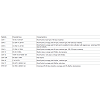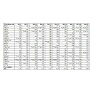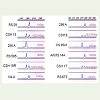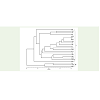Diagnostic Set of Microsatellite Markers forHybrid Purity Testing and Molecular Identification of Hybrids and Parental LinesSorghum
Lalit Arya1*, Manjusha Verma1 and Suman Lakhanpaul2
Corresponding author: Lalit Arya, National Bureau of Plant Genetic Resources, Pusa Campus, New Delhi-12, India,; E-mail: lalitnbpgr@rediffmail.com; lalitarya@nbpgr.ernet.in
1National Bureau of Plant Genetic Resources, Pusa Campus, New Delhi-12, India
2Department of Botany, University of Delhi, Delhi-110007, India
Citation: Arya L, Verma M, Lakhanpaul S. Diagnostic set of microsatellite markers for hybrid purity testing and molecular identification of hybrids and 02 parental lines in sorghum. J Plant Sci Res. 2014;1(1): 103.
Copyright © 2014 Lalit Arya et al. This is an open access article distributed under the Creative Commons Attribution License, which permits unrestricted use, distribution, and reproduction in any medium, provided the original work is properly cited.
Journal of Plant Science & Research | ISSN: 2349-2805 | Volume: 1, Issue: 1
Article Information: Submission: 29/01/2014; Accepted: 03/03/2014; Published: 07/03/2014
Abstract
Ten sorghum hybrids (seven kharif, two dual purpose and one rabi types) along with their thirteen parental lines were utilized for molecular identification and hybrid purity testing in the present study. Ten out of 11 microsatellite (or SSRs-simple sequence repeats) markers used were polymorphic (90.9%) with 2 to 6 alleles (average 3.4 alleles) and PIC (Polymorphism Information Content) valueranged from 0.28 to 0.61. All the ten polymorphic markers revealed polymorphism between the male and female parents of one or more hybrids and would be useful for their hybridity testing. Further, Sb5-236 and Sb4-15 have been identified as the two diagnostic markers for the genetic purity testing of all the ten sorghum hybrids included in this study. Sb6-42, Sb4-22 and Sb5-236 individually or a combinationof Sb6-42/Sb4-22 and Sb5-236 could distinguish three and five hybrids respectively and can be used as referral set of markers for identification and protection of sorghum hybrids (CSH 13, CSH 15R, CSH 1, CSH 14 and SPH 837). All the kharif/dual purpose and rabi sorghum hybrids were grouped in separate clusters. Diagnostic/referral set of SSR markers will aid in hybrid breeding programme ofsorghum.
Keywords: Sorghum; Microsatellite markers; Hybrids; Purity testing
Introduction
Sorghum is a very important high biomass producer C4 plant and has been considered as a 4F crop for its usage as food, feed, fodder and fuel crop. In India it is grown in many states from Tamil Nadu to Uttarakhand in two seasons, namely rainy (kharif) and post-rainy (rabi) season. Sorghum is the second crop after maize in developing high yielding hybrids using cytoplasmic-genic male sterility system.So far, approximately 30 hybrids and 26 varieties have been released nationally besides many more state releases. Hybrid purity is very much essential for its high commercial value and production of certified hybrid seeds. Compared to conventionally used ‘grow-out test (GOT)’ for hybrid purity testing, molecular markers based testing is more effective as it is not affected by environmental factors and time constraints. Among the available molecular markers, SSRs offers an important DNA marker system for hybrid purity testing because of their co-dominance, reproducibility, robustness, and multi-allelic nature. SSR markers can be used to generate unique DNA fingerprints useful for the identification/molecular characterization of parental lines and hybrid purity testing in sorghum. The SSR markers have been used for the assessment of purity of hybrids and parental lines in other crops [1-5] and in sorghum RAPD markers have been used before for hybrid purity testing [6,7]. The present study was undertaken with the objective to identify or develop diagnostic set of SSR markers showing polymorphism between parental lines of different hybrids of sorghum.
Materials and Methods
Plant materials
A total of 23 sorghum genotypes Table 1 including 10 hybrids and 13 parental lines [A-line (cytoplasmic male sterile line/female parent) and R-line (fertility restorer line/male parent)] were used for SSR profiling.
DNA extraction
Genomic DNA of bulk (20 plants/genotype) leaves was extractedusing CTAB method [8]. DNA quantification was done using H33258dye in a fluorometer (Hoeffer Scientific, San Francisco, USA) withcalf thymus DNA as standard.
PCR amplification
For SSR analysis the following reaction components were used: 30 ng of genomic DNA, 2.5 mM MgCl2, 1U AmpliTaq Gold DNA polymerase (PE Applied Biosystems), 1x PCR buffer without MgCl2, 0.3 μM forward and reverse SSR primers each and 0.2 mM dNTP mix. A total of 11 labeled (forward primers labeled with FAM/HEX/TET dyes) SSR primers were used for SSR profiling [9,10]. Thermocycling conditions used for PCR amplification were: denaturation at 95°C for 10 min. followed by twenty five cycles of denaturation at 95°C for 1 min, primer annealing at 55°C for 2 min, and primer extension at 72°C for 2 min, and final extension step was done at 72°C for 10 min. All the PCR amplification was carried out in Gene Amp PCR system 9600 (PE Applied Biosystems). PCR products (1.0 μl) were mixed with 0.5 μl of Gene Scan 500 ROX (in case of HEX and FAM labeled primers) or TAMRA 500 (in case of TET labeled primers) internal size standard, 12.0 μl of de-ionized formamide and were denatured at 96°C for 6.0 minutes. The denatured PCR products were run on ABI PRISM 310 Genetic Analyser.
Data analysis
Data was analysed by Gene ScanR 3.1 analysis software. Electropherograms were generated and the data was converted to binary unit characters (1.0= present, 0= absent) using Genotyper (Version 2.5, Perkin-Elmer/ABI) software. Polymorphism Information content (PIC) value was calculated as described by Botstein [11]. Then NTSYS-pc version 2.1 [12] was used to calculate Jaccard’s similarity coefficient [13] and UPGMA based cluster analysis.
Results and Discussion
Genetic purity testing of hybrids is mandatory for the successful seed production. Co-dominant DNA markers like SSRs produce unambiguous banding patterns useful for hybridity and hence purity testing. In the present study eleven SSR markers were used for the identification of ten sorghum hybrids along with their parental lines, indicating the application of this technique to distinguish the hybrids from its parental lines and hybrid purity testing Figure 1. Of all the 11 primers pairs used in this study, Sb5-256 was monomorphic, showing only one allele of 171 bp in size. Ten markers showed polymorphism (90.9%) with 2 to 6 alleles (average 3.4 alleles) and 0.28 to 0.61 PIC value. All the ten polymorphic markers showed polymorphism between the parents of one or more hybrids Table 2. And for a particular SSR marker parental lines of one to three hybrids showed unique fingerprints. Sb6-42 produced highly polymorphic patterns with six alleles of size 181, 183, 185, 187, 191, 193 bp among different hybrids and their parents. Banding patterns for Sb5-236, Sb1-1 and Sb4-22 also displayed high polymorphism, with four alleles each. Maximum number of seven sorghum hybrid combinations and their parental lines could be distinguished easily by using only one primer pair Sb5-236 followed by Sb4-15 (six sorghum hybrids and their male and female parents). All the ten sorghum hybrids and their parental lines could be distinguished using two primer pairs Sb5-236 and Sb4-15 and would serve as potential set of markers for genetic purity testing of these ten sorghum hybrids. Out of ten polymorphic SSR primer pairs eight showed unique fingerprints for one to three hybrids viz. Sb1-1 (CSH 1), Sb6-57 (CSH 9), Sb6-84 (CSH 15R), Sb6-42 (CSH 13, CSH 15R and CSH 1), Sb4-72 (CSH 17), Sb4-22 (CSH 13, CSH 15R and CSH 1), Sb5-236 (CSH 14, CSH 15R and SPH 837), Sb4-121 (CSH 6). Sb6-42, Sb4-22 and Sb5-236 individually or a combination of Sb6-42/Sb4-22 and Sb5-236 could distinguish three and five hybrids respectively and can be used as diagnostic set of markers for identification and protection of these sorghum hybrids.




